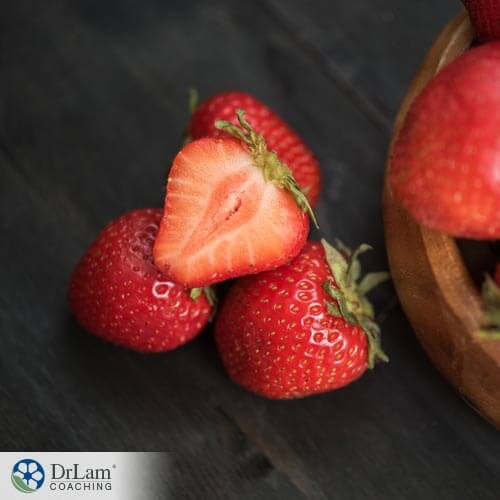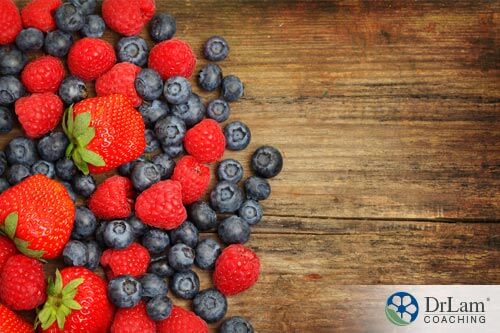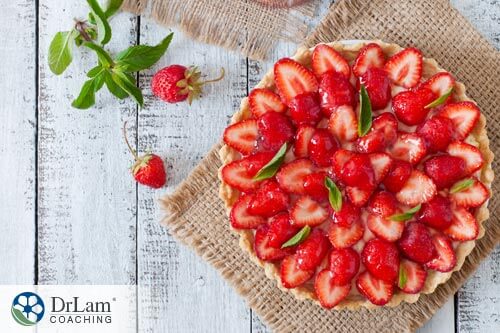 As springtime and summer approaches, fresh fruits start to become abundant in farmers markets and grocery stores. One such gem that is looked forward to is the strawberry. Vibrantly red in appearance, sweet and tart, juicy and delicious is the fruit of Fragaria with over 600 different species. Although candy-like in its taste, the strawberry is not a worthless piece of sugar. It is filled with many nutrients such as fisetin, folate, niacin, vitamins A, C, E, and K, potassium, iron, and lutein, all of which are essential vitamins and minerals for your healthy lifestyle.
As springtime and summer approaches, fresh fruits start to become abundant in farmers markets and grocery stores. One such gem that is looked forward to is the strawberry. Vibrantly red in appearance, sweet and tart, juicy and delicious is the fruit of Fragaria with over 600 different species. Although candy-like in its taste, the strawberry is not a worthless piece of sugar. It is filled with many nutrients such as fisetin, folate, niacin, vitamins A, C, E, and K, potassium, iron, and lutein, all of which are essential vitamins and minerals for your healthy lifestyle.
One previously unknown substance found in strawberries is fisetin. Salk Cellular Neurobiology Laboratory scientist, Pamela Maher, and her team have been studying this. It is an antioxidant which means it helps to protect the body from oxidative stressors. It helps to promote healthy brain cells and maintain proper levels of glutathione which fights against peroxides and free radicals. Lastly, this chemical has been shown to decrease neurological problems such as memory loss that is similar to dementia.
Fisetin is considered to be a flavonoid. Flavonoids are a family of chemicals that are found in fruits and vegetables that (with the help of carotenoids) provide the vibrant color that you see. Flavonoids have many anti-inflammatory benefits and assist to boost the immune system. They also have been used with some Chinese and Ayurvedic medicines as healing foods.
While the term chemical can be confusing, flavonoids are not chemicals like the ones used in harmful ways such as pesticides. These chemicals are merely part of the genetic makeup of fruits and vegetables. Other family members in the flavonoids are anthocyanidins (heart-healthy antioxidants found in berries, wines, and plums), flavonols (present in onions, Brussel sprouts, and broccoli which help to decrease allergic reactions), and isoflavones (found in soybeans and legumes that work to lower risk of breast and prostate cancers).
Flavonoids, like the ones in strawberries, have been studied in animal and human groups, but the results are inconsistent. Pamela Maher used mice in her study, and the group that was fed fisetin supplements for seven months responded better with mental tests and tasks. In addition, they had lower stress and inflammatory levels in their blood than the ones that did not have this chemical supplementation. However, Maher used genetically altered mice that would age at a faster rate than typical mice which may or may not affect the outcome when anticipating results from human participants.
In humans, the results of the studies were inconsistent and somewhat unexpected. In one study by the European Journal of Epidemiology, there was a 50 percent decreased risk in acquiring dementia with increased supplementation, but two other studies, published in the Journal of American Medical Association and the Archives of Neurology, only found the decreased risk of dementia in smokers. The non-smoking groups had no decreased risk. A fourth study, published in the American Journal of Epidemiology, found that those who had increased dietary intake of fisetin seemed to have better mental performance and mentally declined slower than adults who did not have the increased intake.
The body responds in multiple ways to stress. Most of the time the stress is not noticed as the body handles it efficiently. Whenever the body sees a stressor, like an allergen or a stressful day, it begins the NeuroEndoMetabolic (NEM) Stress Response by releasing cortisol. Cortisol is a potent anti-inflammatory agent. When a stressor is found, it signals throughout the whole body to return it to normal. Unfortunately, there is always a breaking point. When the body cannot produce enough cortisol to deal with the stress that is present, then adrenal fatigue and its related symptoms start to show up.
Adrenal Fatigue Syndrome (AFS) is found in common complaints as fatigue and tiredness, trouble thinking, worsening allergies, and brain fog. It often gets confused with symptoms like in those who are in high-stress conditions or recently had a major catastrophe (like a death in the family). The body attempts to compensate for a while, but eventually it cannot.
 The symptoms are vague and reflect a multitude of other conditions which is why AFS is difficult to assess for most therapists. The neuroaffect circuit of the NEM stress response shows symptoms such as
The symptoms are vague and reflect a multitude of other conditions which is why AFS is difficult to assess for most therapists. The neuroaffect circuit of the NEM stress response shows symptoms such as
Fisetin in strawberries has the potential to decrease inflammation that can hurt the brain. When increased inflammation is present here, it can cause dementia, affect your neuroaffect circuit, and lead to other cognitive disabilities like loss of memory and difficulty moving your arms and legs. The healthiest fruits contain the best amounts of vitamins and minerals. When shopping for strawberries, to help with good supplementation, try to buy organic strawberries if at all possible to avoid pesticides. If you cannot get organic, make sure you wash them in a solution of vinegar and water to help remove any unwanted chemicals and pesticides.
In a six year study, starting in 1995, strawberries and blueberries were tested to see if cognitive (mental) levels would change with a diet that was high in these fruits. The study was just for women, seventy years and older. Among the 16,010 women who were in the study, it found that their mental decline slowed by an average of two years by eating these fruits.
 Strawberries are also high in fiber, as well as vitamins and minerals. With the increased fiber, the body can detoxify itself and excrete waste products at a more efficient rate. When the digestive tract is flowing freely (i.e., not suffering from constipation) inflammation in the gut is not building up, and the pH can balance itself out properly. One cup of fresh strawberries is equal to about ten percent of your daily fiber needs. This is great for your detoxification circuit.
Strawberries are also high in fiber, as well as vitamins and minerals. With the increased fiber, the body can detoxify itself and excrete waste products at a more efficient rate. When the digestive tract is flowing freely (i.e., not suffering from constipation) inflammation in the gut is not building up, and the pH can balance itself out properly. One cup of fresh strawberries is equal to about ten percent of your daily fiber needs. This is great for your detoxification circuit.
As the body continues to mature and age, so do the cells. Eventually, they are unable to divide and grow anymore, and this process is called senescence. A senolytic compound, like the one that is found in strawberries, is needed to help break down these cells for the body to remove them. Usually, the body does this on its own through a process called apoptosis, also known as cell death.
Whenever a new study is released, it is easy to think that you should go down to your local health food store and pick up another supplement. So yes, this may seem like a good response, but it is not. Adding additional supplements without the guidance of your healthcare practitioner is always potentially dangerous. What may be considered “safe” for a healthy adult may not be safe for you. "One man’s poison is another man’s cure," as the adage goes.
The best way to increase fisetin in your diet is to add it from a balanced diet. Balance is the focus here. It does not mean you should only eat strawberries and nothing else, but gently increasing your fruits and vegetables to proper levels is essential. Try this recipe for a delicious boost of fisetin.

Optional: Serve chilled pie with a heaping scoop of vegan cashew milk, vanilla flavored ice-cream.
Yes, but only if you increase fisetin in your diet by eating healthy foods. You shouldn’t go out and buy another supplement without approval from your practitioner. Also, it does not mean you should only eat strawberries and nothing else, but instead increasing your fruits and vegetables to proper levels.
